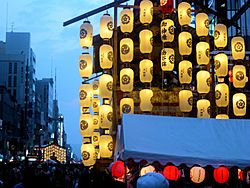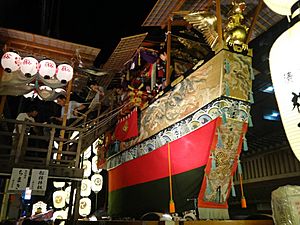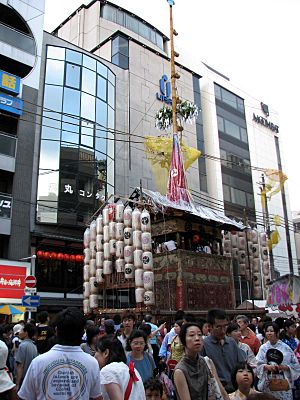Gion Matsuri facts for kids
Quick facts for kids Gion Festival (Gion Matsuri) |
|
|---|---|

Yoiyama during the Gion Festival
|
|
| Observed by | Kyoto |
| Type | Religious |
| Begins | 1 July |
| Ends | 31 July |
| Date | Month of July |
The Gion Festival (祇園祭 (Gion Matsuri)) is one of the biggest and most famous festivals in Japan. It happens every year in July in Kyoto. Many events take place in central Kyoto and at the Yasaka Shrine. This shrine is in Kyoto's famous Gion district, which gives the festival its name.
The Gion Festival is a Shinto festival. It first started to protect people from sickness and bad spirits. Many ceremonies happen during the festival. It is best known for its two large float parades, called Yamaboko Junkō (山鉾巡行). These parades happen on July 17 and July 24.
The three nights before each parade are very special. They are called yoiyoiyoiyama (宵々々山), yoiyoiyama (宵々山), and yoiyama (宵山). During these evenings, Kyoto's downtown area is only for people walking. Some traditional houses open their doors to the public. They show off old family treasures in a custom called the Folding Screen Festival (屏風祭り, Byōbu Matsuri). Also, the streets are full of night stalls. They sell tasty foods like yakitori (barbecued chicken), taiyaki, takoyaki (fried octopus balls), and okonomiyaki. You can also find traditional Japanese sweets and many other delicious treats.
Contents
History of the Gion Festival

How the Festival Began
The Gion Festival started a long time ago, in 869. Many people were getting sick from a terrible plague. People believed that angry spirits were causing the sickness, as well as fires, floods, and earthquakes. To make these spirits happy, Emperor Seiwa ordered prayers to Susanoo-no-Mikoto. This is the god of the Yasaka Shrine.
Sixty-six decorated spears, called halberds, were set up. Each spear stood for one of Japan's traditional provinces. These were placed in a garden called Shinsen-en, near the imperial palace. Small, portable shrines called mikoshi (御輿) from Yasaka Shrine were also brought there. This special ceremony was repeated whenever a plague happened.
The Festival Becomes a Yearly Event
By the year 1000, the Gion Festival became an event that happened every year. It has almost always taken place since then. However, during a civil war called the Onin War in the late 1400s, central Kyoto was badly damaged. The festival stopped for 30 years. Later, in the 1500s, a powerful leader named Oda Nobunaga helped bring it back.
Over hundreds of years, some of the festival floats were damaged or lost. In recent times, many have been fixed up. The groups that own the floats sometimes buy old tapestries to replace worn-out ones. They might also order new ones from weavers in Kyoto's famous Nishijin weaving district. When the floats are not being used, they are kept in special storage buildings in Kyoto or at Yasaka Shrine.
The Gion Festival is also an important part of a famous book. It is featured in the novel The Old Capital by Yasunari Kawabata. He describes it as one of the "three great festivals" of Kyoto. The other two are the Festival of Ages and the Aoi Festival.
Schedule of Gion Festival Events
The Gion Festival is a month-long celebration with many special events. Here are some of the main activities:
- July 1–5: Kippuiri, the opening ceremony for the festival in each neighborhood.
- July 2: Kujitorishiki, a lottery to decide the order of the floats in the parade. This happens at the city hall.
- July 7: Special visit to the shrine by chigo children from Ayagasaboko.
- July 10: Lantern parade to welcome the mikoshi (御輿) (portable shrines).
- July 10: Mikoshi arai, where the mikoshi are cleaned with sacred water from the Kamo River.
- July 10–13: The building of the huge festival floats begins.
- July 13 (morning): Shrine visit by chigo children from Naginataboko.
- July 13 (afternoon): Shrine visit by chigo children from Kuse Shrine.
- July 14: Yoiyoiyoiyama, the first of the three special evenings.
- July 15: Yoiyoiyama, the second special evening.
- July 16: Yoiyama, the last special evening before the main parade.
- July 16: Yoimiya shinshin hono shinji, performances of traditional arts.
- July 17: The first big parade of yamaboko floats.
- July 17: Parade of mikoshi from Yasaka Shrine.
- July 18–20: More floats are built for the second parade.
- July 21: Yoiyoiyoiyama, for the second parade.
- July 22: Yoiyoiyama, for the second parade.
- July 23: Yoiyama, for the second parade.
- July 24: The second parade of yamaboko floats.
- July 24: Parade of hanagasa (花傘, 'flower parasols').
- July 24: Parade of mikoshi returning to Yasaka Shrine.
- July 28: Mikoshi arai, cleaning of mikoshi with sacred water from the Kamo River.
- July 31: The closing ceremony at Eki Shrine.
Yamaboko Floats: The Stars of the Parade
The amazing floats in the Gion Festival parades are called yamaboko. They are split into two groups: the larger hoko ("halberd") and the smaller yama ("mountain").
There are ten hoko floats. They remind people of the 66 spears used in the very first purification ceremony. The 24 yama floats carry life-sized figures. These figures represent Shinto gods, Buddhist figures, and other important people from history.
All the floats are beautifully decorated with many different tapestries. Some are made in Nishijin, Kyoto's traditional weaving area. Others have been brought from all over the world. Experts from around the world know about the Gion Festival's unique collection of textiles.
Musicians sit on the floats and play drums and flutes. The floats are pulled down the street with ropes. Good luck charms are often thrown from the floats to the crowd. The Yamahoko floats are so special that they are listed as an important cultural heritage by UNESCO.
The Mikoshi Parade
On the evening of July 17, hundreds of men carry the portable mikoshi shrines. These shrines hold the gods of Yasaka Shrine. They are carried through different neighborhoods to a temporary home called the otabisho in central Kyoto. People believe that the gods purify, or cleanse, all the neighborhoods they pass through. The gods stay at the otabisho for one week, between the two main float parades. On July 24, they are carried back to Yasaka Shrine, their permanent home. On the way back, the parade stops at Shinsen-en. This was the original place where the first ceremonies happened in 869.
Float Order and Special Roles
Every year, the neighborhood groups that take care of the floats draw lots in early July. This lottery decides the order in which the floats will appear in the parades on July 17 and July 24. These lottery results are shown in a special ceremony at the start of the parades. The Mayor of Kyoto even wears special robes for this event.
One special float is the Naginata Hoko. It features a chigo, a young boy chosen from Kyoto's merchant families. He wears a special robe and a golden phoenix. This boy is chosen to be a sacred helper for a god. For several weeks, he goes through special cleaning ceremonies. He lives apart from others and cannot touch the ground. So, he is carried around in a special wagon. At the start of the yamahoko parade on July 17, the chigo cuts a sacred rope with a swing of his sword.
Hoko Floats: Giant and Impressive
- Weight: About 12 tons (that's like 12 small cars!)
- Height: About 27 meters (as tall as a 9-story building!)
- Wheel diameter: About 1.9 meters (taller than most people!)
- Attendants: About 30–40 people pull the float during the parade. Usually, two men guide it with special wedges.
Yama Floats: Smaller but Still Grand
- Weight: 1,200–1,600 kg (about the weight of a small car)
- Height: About 6 meters (as tall as a two-story house)
- Attendants: 14–24 people are needed to pull, push, or carry these floats.
See also
 In Spanish: Gion Matsuri para niños
In Spanish: Gion Matsuri para niños
- Gion cult




